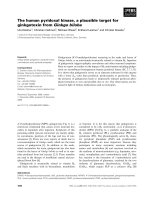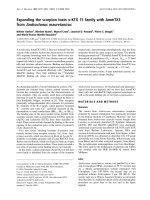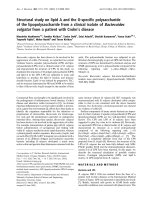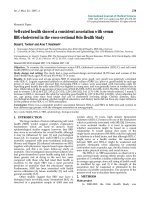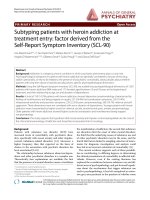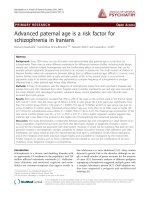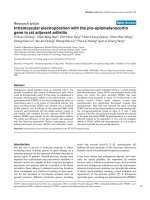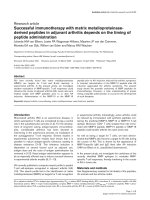Báo cáo y học: " B-cell depletion with rituximab: a promising treatment for diffuse cutaneous systemic sclerosis" doc
Bạn đang xem bản rút gọn của tài liệu. Xem và tải ngay bản đầy đủ của tài liệu tại đây (124.38 KB, 2 trang )
‘No drug should be discarded until it has been tried in
systemic sclerosis’. A phrase of this sort can still be found
in many textbooks and reviews on systemic sclerosis
(SSC), but the time has come to raise our expectations.
e study by Bosello and colleagues [1] in this issue of
Arthritis Research & erapy provides tantalizing data on
the eff ects of rituximab in nine patients with diff use
cutaneous systemic sclerosis (dcSSc) nonresponsive to
cyclophos phamide. A single treatment course induced a
consistent and sustained improvement of skin thickening,
disease activity, and functional ability, notably in the
seven patients with early disease. In those with organ
involvement, function remained stable. Re treat ment was
given in one patient with clinical relapse and pre-
emptively in two patients who had rapid recon stitution of
B cells. e clinical eff ects were paralleled by biological
eff ects, including depletion of circulating B cells, and
changes in serum levels of interleukin-6 (IL-6) and BAFF
(B-cell activating factor of tumor necrosis factor family).
IL-6 has a role in fi brogenesis, and the reduction in IL-6
following rituximab treatment may be one of the
explanations for the eff ect on skin fi brosis as found in this
and other recent studies. Several cell types produce IL-6,
including B cells, macrophages, and stromal cells, and so
the eff ect of rituximab on IL-6 in dcSSc could be due to
direct depletion of IL-6-producing B cells or, more likely,
indirect eff ects of B-cell depletion on IL-6 production by
stromal cells or macrophages or both.
e study extends the results of other recently
published papers reporting clinical benefi t of rituximab
therapy [2-4]. Together, they confi rm earlier predictions
that B cells might be an attractive target in SSc [5,6].
What is most striking in these studies is the prospect that
this drug has a more favorable risk-to-benefi t ratio of
treatment when compared with other therapies such as
imatinib, cyclophosphamide, or immunoablative therapy
and autologous stem cell transplantation. No serious
adverse events attributable to rituximab were reported in
any of the rituximab studies, and toxicity seemed mild at
worst. In contrast, remarkable eff ects on skin thickening
were found in three of the four studies, including a small
placebo-controlled, randomized trial [1,3,4]. All three, in
contrast to the fi rst published study, in which a single
treatment course failed to induce a marked eff ect on skin
thickening [2], involved either optional or preplanned
repeat treatment. In one case, repeat treatment was
successfully continued at 6-month intervals for 2 years
[7]. e one randomized trial and a number of case
reports also showed a benefi cial eff ect of rituximab
treatment on SSc lung disease [3,8,9].
So what’s the price? First, rituximab (and any other
biological for that matter) does not come cheap,
especially when repeat treatment is necessary. As a result
of this and in the absence of consensus or guidelines on
the use of biologicals in connective tissue diseases such
as SSc, access is problematic in many health care systems.
Second, although rituximab is generally well tolerated (as
exemplifi ed in the SSc patients treated so far), studies in
Abstract
Recent preclinical and clinical studies lend support
to the notion that B-cell depletion is a promising
therapeutic target in patients with di use cutaneous
systemic sclerosis. A recent open-label trial provides
further evidence showing marked e ects of rituximab
treatment on skin thickening, functional ability, and
disease activity in conjunction with e ects on lesional
and circulating B cells and on interleukin-6 and BAFF
(B-cell activating factor of tumor necrosis factor family).
The excellent safety pro le of rituximab in this and
other trials warrants further well-designed clinical trials
in larger patient groups combined with comprehensive
biomarker studies.
© 2010 BioMed Central Ltd
B-cell depletion with rituximab: a promising
treatment for di use cutaneous systemic sclerosis
Jacob M van Laar*
See related research by Bosello et al., />EDITORIAL
*Correspondence:
Musculoskeletal Research Group, Institute of Cellular Medicine, Newcastle
University, 4th Floor, Cookson Building, The Medical School, Framlington Place,
Newcastle upon Tyne, NE2 4HH, UK
van Laar Arthritis Research & Therapy 2010, 12:112
/>© 2010 BioMed Central Ltd
other conditions have suggested an increased, albeit low,
risk of progressive multifocal leukoencephalopathy in
patients on concomitant or previous immunosuppressive
therapy. Of note, numbers of circulating B cells and
serum concentrations of IgM dropped signifi cantly in the
study by Bosello and colleagues [1], consistent with data
in rheumatoid arthritis, but long-term safety data on
repeat treatment in SSc are lacking. In the context of the
poor prognosis of dcSSc, the risk of infection may be one
worth taking in patients with few eff ective treatment
options. ird, rituximab is not eff ective in all patients
and, in one case, reportedly had divergent eff ects on
diff erent disease manifestations [10]. In this patient,
rituximab had an eff ect on myositis, but not on skin
thickening. At present, it is not possible to predict which
SSc patient will respond to rituximab, as illustrated by
the obser vation that rituximab was also eff ective in SSc
patients whose skin biopsies did not contain detectable
B-cell numbers. Whether this points to sampling error or
a pathogenetic role of B cells at other sites (for example,
lymph nodes) remains to be determined. Clearly, improved
prediction models are needed.
e combined results of recent rituximab studies
warrant adequately powered clinical trials in larger
patient groups to compare safety and effi cacy of
rituximab versus placebo or rituximab versus conven-
tional therapy (for example, cyclophosphamide, at the
moment still the considered the gold standard for severe
SSc). Long-term outcome analyses are essential to evalu-
ate feasibility, safety, and effi cacy of (repeat) treat ment.
Criteria for retreatment should be developed once
effi cacy of a single treatment course has been proven. To
understand whether and how rituximab aff ects the
diff erent patho genetic pathways implicated in SSc, com-
pre hensive biomarker studies should be part of the
clinical trial protocol. Such trials require a multicenter,
maybe even a multinational, approach and concerted
action from specialists, patients, and funding agencies.
Any such trial will be costly and complex and demand
stamina and creativity to deal with study methodology
issues resulting from its low incidence, heterogeneity in
clinical presentations, and natural disease course. With a
potentially eff ective and relatively safe drug in hand,
however, the time has come to try to break the deadlock
in SSc treatment.
Abbreviations
dcSSC, di use cutaneous systemic sclerosis; IL-6, interleukin-6; SSc, systemic
sclerosis.
Competing interests
JMvL has received a research grant, consultancy and speaker’s fees from
Roche UK. Roche is not nancing this manuscript.
Published: 22 April 2010
References
1. Bosello S, De santis M, Lama G, Spano C, Angelucci C, Tolusso B, Sica G,
Ferracciolo G: B cell depletion in di use progressive systemic sclerosis:
safety, skin score modi cation and IL-6 modulation in an up to thirty-six
months follow up open-label trial. Arthritis Res Ther 2010, 12:R54.
2. Lafyatis R, Kissin E, York M, Farina G, Viger K, Fritzler MJ, Merkel P, Simms RW: B
cell depletion with rituximab in patients with di use cutaneous systemic
sclerosis. Arthritis Rheum 2009, 60:578-583.
3. Daoussis D, Liossis SC, Tsamandas AC, Kalogeropoulou C, Kazantzi A, Sirinian
C, Karametsou M, Yiannopoulos G, Andonopoulos AP: Experience with
rituximab in scleroderma: results from a 1-year, proof-of-principle study.
Rheumatology 2010, 49:271-280.
4. Smith V, Van Praet JT, Vandooren B, Van der Cruyssen B, Naeyaert JM,
Decuman S, Elewaut D, De Keyser F: Rituximab in di use cutaneous
systemic sclerosis: an open-label clinical and histopathological study. Ann
Rheum Dis 2010, 69:193-197.
5. Wollheim FA: Is rituximab a potential new therapy in systemic sclerosis?
New evidence indicates the presence of CD20-positive B-lymphocytes in
scleroderma skin. J Clin Rheumatol 2004, 10:155.
6. Kraaij MD, van Laar JM: The role of B cells in systemic sclerosis. Biologics
2008, 2:389-395.
7. Daoussis D, Liossis SC, Tsamandas AC, Kalogeropoulou C, Kazantzi A, Kor atis
P, Yiannopoulos G, Andonopoulos AP: Is there a role for B-cell depletion as
therapy for scleroderma? A case report and review of the literature. Semin
Arthritis Rheum [Epub ahead of print].
8. McGonagle D, Tan AL, Madden J, Rawstron AC, Rehman A, Emery P, Thomas S:
Successful treatment of resistant scleroderma-associated interstitial lung
disease with rituximab. Rheumatology 2008, 47:552-553.
9. Yoo WH: Successful treatment of steroid and cyclophosphamide-resistant
di use scleroderma-associated interstitial lung disease with rituximab.
Rheumatol Int 2010 Jan. 8 [Epub ahead of print].
10. Fabri M, Hunzelmann N, Krieg T: Discordant response to rituximab in a
systemic sclerosis patient with associated myositis. J Am Acad Dermatol
2008, 58 (5 Suppl 1):S127-128.
doi:10.1186/ar2977
Cite this article as: van Laar JM: B-cell depletion with rituximab:
apromising treatment for di use cutaneous systemic sclerosis. Arthritis
Research & Therapy 2010, 12:
112.
van Laar Arthritis Research & Therapy 2010, 12:112
/>Page 2 of 2

